STAR’s Reading FC Hall of Fame
The Hall of Fame is a work-in-progress project scheduled to complete on the 150th anniversary of Reading FC’s first match in 1872. Each year between 2016 and 2022 11-25 new names will be added (inducted) into the Hall of Fame.
In total there will be about 150 inductees fairly even spread across the 15 decades of the club’s history. Nomination is open to any individual that has played an exceptional or distinctive part in the life of the club. The Hall of Fame should not be seen as a ‘long service’ award. Specifically, it should include players, managers, officials, journalists and supporters.
A range of well-informed supporters has put forward initial recommendations to STAR. These have then been considered in terms of merit and popularity by a panel consisting of STAR Board members and outside experts who will determine the final selection of the latest round of inductees each year. Supporters are welcome to take part in future initial recommendation stages. Please email media@star-reading.org for further details.
1920s
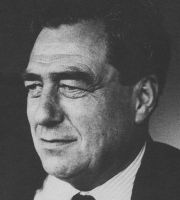
John Arlott
Reading career: Supporter from the 1920s onwards
Claim to fame: The first well-known personality to speak up as a Reading fan
John Arlott was the first nationally, indeed possibly internationally, known supporter of Reading FC. Whilst famed as one the very greatest cricket broadcasters he was also for some time a football journalist and kept his support for unfashionable Reading public in the press rooms of the nation and in his biographical work.
Read more...
Leslie Thomas John Arlott OBE; a journalist, writer, poet and wine connoisseur was born on 25th February 1914 in Basingstoke, North Hampshire, an area that has done much to support the club over the years. An avid football supporter, as a young man he cycled regularly the 17 miles from his Basingstoke home to watch the Biscuitmen at Elm Park. He notoriously failed his entrance examination for Cambridge University by leaving the room after the first hour to go and watch a Reading cup tie.
After leaving school and brief employment as a clerk at Basingstoke Town Hall and four years working as a records clerk at Park Prewett Mental Hospital in Basingstoke John Arlott joined the Southampton County Borough Police Force where he served for 12 years rising to the rank of sergeant; using every opportunity to watch Hampshire Cricket Club.
Coming to the attention of the BBC in 1945 he was invited to join its Overseas Service in 1946 initially to commentate on England’s warm up games for India’s tour of England he made such an impression that he was invited to commentate on the subsequent Test matches, thus launching a 34 year broadcasting career in which he commentated on every home Test match in his popular poetic style aided by a distinctive voice, described by fellow Guardian journalist, Frank Keating as an, “articulate, leisurely, confiding countryman’s burr”. His contribution to British radio is commemorated in the Royal Academy’s Hall of Fame.
A liberal and humanitarian, he stood for Parliament as a Liberal Party candidate unsuccessfully twice. He was an outspoken critic of the England selectors’ initial failure to select Basil D’Olivera for the 1968 tour of South Africa amidst allegations of South African political interference with the selection committee. A result of which was his vow never to commentate on South Africa again, but following the cancellation of the 1968 and 1970 tours South Africa was ostracised from World cricket until the release from prison of Nelson Mandela in 1991.
John Arlott retired from cricket commentary and journalism at the end of the 1980 cricket season and moved to Alderney, where he died peacefully in his sleep on 14 December 1991.
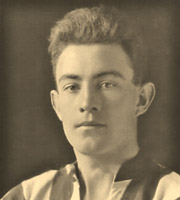
Billy McConnell
Reading career: 1924-28
161 appearances
1 goal
Claim to fame: Tough, title-winning full back, once our most capped player
McConnell joined from Slough, who he had helped win the Berks & Bucks Cup at the age of only 16, in May 1924. He was virtually ever present at left back for the next four seasons, until injury ended his career. A tough competitor who ‘used his strength to the full’ he was Reading’s most capped international for 70 years, being selected for 10 consecutive Irish internationals.
Read more...
Injury and club commitments restricted him to eight starts. He won a Division Three South championship medal with the Biscuitmen in 1925-26. One of our most popular pre-war players, Billy broke his ankle while courageously scoring his only goal for us against Middlesbrough in 1927. He made several comeback attempts, including a brief spell in goal for the reserves, before finally quitting. He then became a Football League linesman and refereed several wartime games at Elm Park as well as playing in the town’s first ever floodlit game staged at the old Oxford Road Greyhound Stadium in September 1934.
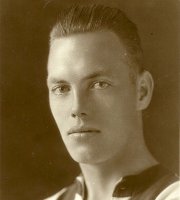
Alf Messer
Reading career: 1923-1930
Apps: 295
19 goals
Claim to fame: International-class kingpin of Reading’s Div III (S) title-winners
Without doubt one of Reading’s greatest players of any era. A dominant centre-half who was tipped for England honours and reckoned to be the best uncapped player of the day.
Read more...
Messer signed for Reading in 1923 and played almost every game until his transfer to Tottenham in 1930 for the large fee of £2,000. He was in the first Reading side to win a Football League promotion in 1926 – the Division III (S) title – and the first side to reach the FA Cup semi-finals the year after. Alf became club captain in 1928. After he moved to Spurs Reading’s defence disintegrated and the club were relegated in 1930-31. He played 295 times for the club scoring 19 goals – a high number for a defender in those days.
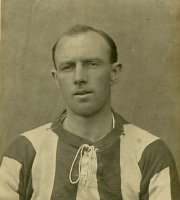
Bert Eggo
Reading career: 1921-1929
Apps: 312
2 goals
Claim to fame: Captain of our first League divisional title-winners in 1926
A calm and skilful right back from Scotland Bert played 312 games for Reading, the most pre-WWII appearances. Previously with Hearts and Sheffield Wednesday he signed in June 1921 “for the price of an old song” for our second League season.
Read more...
He captained the side that won promotion in 1926 from Division III (S) and reached the FA Cup semi-final in 1927 and was seen as the calm and controlling influence in the dressing room. At the age of 34 he retired from the game but continued to live in the town for a while and no doubt watched Arthur Bacon in the Reading team. Sadly they never played together!
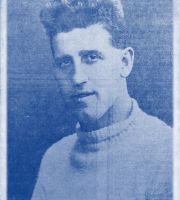
Joe Duckworth
Reading career: 1924-1930
225 appearances
Claim to fame: Consistent and brave goalkeeping in our first title-winning team
Joe served four years in the army during WWI (having tried to join whilst under-age) before a brief spell with First Division Blackburn, his home town club. He moved to Aberdare where, as an opponent, he so impressed Reading we signed him in 1924. Over the next four seasons he missed just one league match as the club rose from the depths of Division Three South to mid-table respectability in Division Two.
Read more...
He won a Division Three South champions medal in 1925-26 (as an ever present) and played in every game in the run to the FA Cup semi-final the following season. His appearance record is remarkable given his outstanding bravery in an extremely physical era for goalkeepers. Perhaps his finest moment was keeping a clean sheet in an FA Cup tie in 1929 as Reading knocked out the league champions-elect, Sheffield Wednesday. Joe left Reading in 1930 for Brighton and later returned to Lancashire where he worked as a deckchair attendant on Blackpool beach.
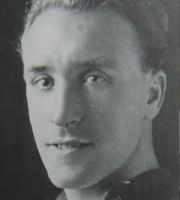
Frank Richardson
Reading career: 1926-1930
103 appearances
55 goals
Claim to fame: A striker who made the difference, helping us to our first FA Cup semi-final and highest league position
Frank was the definition of a great deadline day transfer swoop – if they had them back in 1926. He joined Reading at the age of 29 from Swindon but had First Division experience with Stoke and West Ham under his belt. He played in the last 13 games of the 1925-26 season scoring 12 goals as the Biscuitmen pipped Plymouth (another of his former clubs) to the Division Three South title, including four strikes in the vital last game of the season.
Read more...
Frank was top scorer in Reading’s debut season in Division Two with 19 as we reached our highest league position yet. More memorable was his part in our ten game run to the FA Cup semi-final in 1927. He scored nine times, including four against Manchester U over three games and the only goal in our record home attendance (33,042) victory over Brentford. The fans sang “Rich, Rich, Rich score another goal for me” – one of the first songs for a Reading player, based on the big 1926 hit Chick, Chick, Chick, Chick, Chicken (written by Tommy McGhee).
After turning 30 he was less frequently in the first team and eventually moved back to Swindon in 1930. But he had settled in the Reading area and later coached the youth team in the 1950s and 1960s. When Reading finally, exactly 60 years later, repeated the feat of winning the Division Three title Frank Richardson was the guest of honour and received a very warm reception.
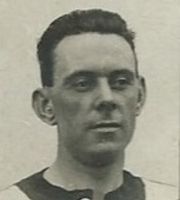
Hugh Davey
Reading career: 1926-1930
66 appearances
44 goals
Claim to fame: Brilliant goal scorer in our 1926 title triumph
Belfast-born centre forward Hugh Davey signed form Bournemouth. He played 61 matches and scored 49 goals an amazing ratio. In the 1925/26 season when the club won the Division 3 South Championship, he finished that season with 23 goals from 24 matches in the league and he also scored 3 goals in the FA Cup. He was small and skilful and won four caps for Northern Ireland while with Reading before leaving to join Portsmouth.
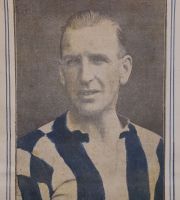
Bill Inglis
Reading career: 1925-1930
136 appearances
1 goal
Claim to fame: Played in all ten FA Cup matches in our run to the 1927 semi-final
A member of the wonderful Reading team of the mid-Twenties, Bill joined Reading from Brentford in June 1925 at the start of our Division Three South championship-winning season. Signed as a centre half, Bill’s first team place was initially blocked by Alf Messer but he quickly adapted his play and established himself alongside Messer as a tough-tackling, dependable wing half, thanks, in part, to his impressive physique. Bill continued to flourish in the Second Division, missing just two games in the next two seasons which, of course, included our run to the semi-finals of the FA Cup in 1927. Eventually, Bill became a less frequent first teamer and in 1930 he was sold to Exeter.
1930s
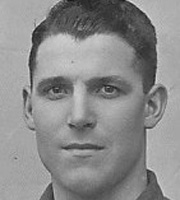
Jack Palethorpe
Reading career: 1930-33
64 appearances
54 goals
Claim to fame: The greatest ‘what might have been’ of the 1930s.
Scandalously under used as a young player, Palethorpe was a prolific scorer and has the best goals per league game record of any Reading player with 54 goals in only 57 starts. Before joining Reading in 1930 at the age of 21 he had scored 65 in 39 games for Maidenhead. Many thought his regular inclusion in the Reading team could have saved the club from the calamitous 1931 relegation.
Read more...
He featured regularly as Reading finished runners-up and fourth in the next two seasons before departing for a large fee to Stoke where he won promotion. He also won promotion at Preston and scored in Sheffield Wednesday’s FA Cup winning side of 1935, leaving Reading fans wondering what might have been, had he stayed.
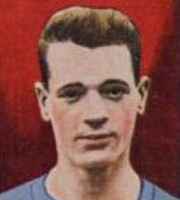
Tommy Tait
Reading career: 1934-39
170 appearances
103 goals
Claim to fame: Instant success and prolific scorer part-funded by Supporters’ Club.
Tommy Tait had already scored goals in all four divisions of the Football League, with Southport, Manchester City, Bolton and Luton, before Reading paid Bournemouth £1,000 for his services in November 1934. Uniquely, £200 of that fee was paid for by the fledgling Reading Football Supporters’ Club and he immediately repaid the fans’ faith by scoring a hat-trick on his debut at Aldershot in a game that also saw him have two other ‘goals’ ruled out for off side.
Read more...
From then on it was goals all the way as Tommy headed our goal-scorers in his first four seasons. A hardworking, aggressive forward, Tommy was also an innovative player who was one of the first centre forwards to roam across the pitch to create space for himself and his fellow forwards, as well as creating confusion among the opposition’s defence. The only black spot on Tommy’s Reading career came on Boxing Day 1934 when he became the first Reading player to be sent off in a League game at Elm Park when he retaliated to persistent fouls by the Millwall defence. Tommy soon got his revenge on Millwall, scoring the goal that knocked them out of the FA Cup a month later to earn Reading a home tie at home to Arsenal. That goal confirmed Tommy’s love of the FA Cup as it was one of 14 that he scored in 15 games in that competition. His dismissal never dimmed his support from the fans so there was uproar when the club announced that Tommy’s contract would not be renewed at the end of the 1937-38 season. The supporters began a petition in an attempt to get their favourite re-signed but Tommy had a better idea, scoring five goals in the next two games to earn himself a new contact.
He finally left Elm Park in 1939, joining Torquay. The start of the Second World War effectively ended Tommy’s playing career although he did return to Reading to make two more appearances as a wartime guest. One of the most popular players in Reading’s history, Tommy died in Cheshire in 1976 at the age of 67.
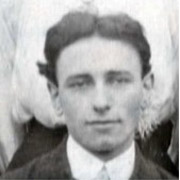
Harry Sirrett
Claim to fame: Local journalist who founded the Supporters’ Club that led to STAR.
As editor of the Football Chronicle H H Sirett was an influential commentator on Reading Football Club and, with the Chronicle holding shares in the club, he attended an Extraordinary General Meeting called in November 1930 by shareholders angry at the team’s poor form. There had been several attempts to form a supporters’ club at Reading. As a concession during the heated meeting, the board reluctantly agreed to allow the formation of a such an organisation.
Read more...
Mr Sirrett acted quickly, arranging a public meeting at the Highways Club, Greyfriars Road the following week and publicised it in the Chronicle’s weekend edition. On 1 December 1930 the Reading Football Supporters’ Club was formed and Mr Sirrett was elected its first chairman. By the end of the season the fledgling club had over 1,300 members. Despite providing valuable donations to the football club, the directors did not appear to approve of Mr Sirrett because, in January 1934, he was banned from the ground after his paper criticised the form of some of the players.
Always a supporter of local football Mr Sirrett was president of Whitchurch United in 1939. Harry had an all-round interest in sport, was particularly fund of racing pigeons and patented a type of dart-board. He died in 1948. Apart from a short hiatus in the late 1940s the Supporters’ Club continued its existence until 2002 when it was essentially transformed into STAR.
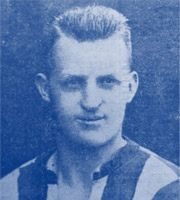
Arthur Bacon
Reading career: 1929-32
67 appearances
44 goals
Claim to fame: Holds the club record for most goals in a single League game.
A big, burly centre forward who signed for a relatively large fee from Manchester City in 1929. Bacon scored an amazing 29 goals in 32 games in our 1930-31 relegation season. This included a still-existing club League record of 6 in the 7-3 defeat of Stoke City, one of which included putting the keeper in the back of the net as well! This was Reading’s last victory at this level of League football for 55 years.
Read more...
His goal-scoring exploits weren’t over when he left Reading in 1932. Whilst at Coventry he scored 15 goals in only 5 games, including 5 and 4 in consecutive matches. Sadly Bacon missed playing in the same Reading side as Bert Eggo by a year! He died during an air raid in WWII while serving as a volunteer fireman at the Rolls Royce aero engine factory in Derby.
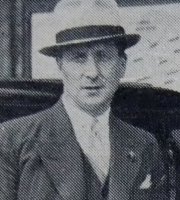
Billy Butler
Reading career: 1933-1939
Apps 67
16 goals
Claim to fame: Famous face on the wing who became innovative manager
Billy was a success as both player and manager at Elm Park. He was a veteran winger with three FA Cup winners’ medals (all with Bolton) and one England cap when he joined Reading in 1933. After 67 appearances he became manager in 1935 in succession to Joe Smith.
Read more...
He was innovative, writing his own programme notes, installing a gymnasium at Elm Park and taking players out into the community. Whilst he came close to winning promotion, winning over 50% of his League matches in charge, his only managerial honour was the Southern Section Cup in 1938 (a ‘prototype’ of the Checkatrade Trophy). Under Billy Reading finished 3rd, 5th and 6th. After the war he coached in southern Africa.
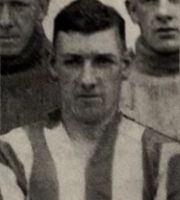
Albert Hayhurst
Reading career: 1933-1939
247 appearances
12 goals
Claim to fame: Consistent centre-half in a record-breaking team
A Yorkshireman Albert joined Reading from Luton in June 1933 on a ‘free’ and went on to play in virtually every game for the next five seasons. He was a late starter, effectively beginning his league career at 28 but made up for that as a wonderfully consistent player, first at centre half and later at right back.
Read more...
In his five seasons at the heart of the defence Reading finished third, second, third, fifth and sixth but never quite managed the one promotion place on offer. However Albert was very much part of the Reading defence that set a new Football League record of 55 undefeated home matches between 1933-35 which stood for thirty years.
Albert was also an inspirational captain and he led Reading to victory in the Southern Section Cup in 1938, our only honour of the decade. It was in another cup game that Albert played the match of his life, marking Arsenal’s legendary free-scoring Ted Drake out of the game against the Gunners in 1935.
Released by Reading at the age of 34 in 1939, WWII virtually ended his career but he did return to Elm Park for one war-time appearance. As well as a great career as a footballer, Albert was a fine cricketer who played seven times for Warwickshire in 1934 and was still playing minor counties cricket in 1953. Albert died in Reading in 1991.
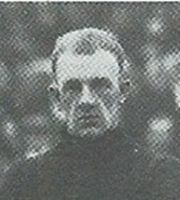
Percy Whittaker
Reading career: 1933-1939
213 appearances
Claim to fame: A keeper clever and brave enough to marry the manager’s daughter
Although just under 5 ft 9 ins tall, Percy Whittaker was a very effective goalie for Reading, making up for his lack of inches with an abundance of bravery. This endeared him to the Elm Park fans but cost him several injuries in the days when keepers received little protection from referees. As a result, he never came close to being ever-present in his six seasons up to 1939, even though he was always the club’s first choice goalie.
Read more...
In 1938 he helped Reading win the Division Three Southern Section Cup while another cause for celebration during his time at Reading was his marriage to the step-daughter of Joe Smith, the manager who brought him to Elm Park from Wolves. Another player whose career was ended by the war, Percy stayed on in Reading as a greyhound owner and was on the training staff at the town’s greyhound stadium.
1940s
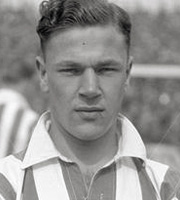
Maurice Edelston
Reading career: 1939-52
223 appearances
80 goals / Journalist
Claim to fame: Olympian, our last great amateur and BBC commentator.
Maurice Edelston was another of Reading’s Olympians and another who lost some of his best playing years and chance of playing for England to the war. As a teenager he played for GB in 1936 Berlin Olympics and won a total of 10 amateur international caps and 5 wartime caps for England. Edelston was a clever and cultured, goal-scoring inside right who signed for Reading in April 1939.
Read more...
He played the three matches of the aborted 1939-40 and then had to wait another 7 years to resume his league career. Clearly he had saved up his goals for he scored hat-tricks in each of his first two home league games, becoming the only amateur ever to do so in league football. He turned professional soon after and played a huge part in one the club’s most entertaining and high-scoring eras (alongside Blackman and McPhee) before leaving for Northampton in 1952.
Amongst other curiosities his first manager was his father, Joe; and he scored the winner when Reading won the London War Cup in 1941 (a significant trophy then – he scored over 100 goals in war-time football). He is best remembered by the wider football world as a long-standing BBC radio commentator, immortalised in the words of fellow-commentator Bryan Butler who declaimed at the crucial moment in the 1966 World Cup Final “I think that hit the bar and went in – Maurice Edelston?”.
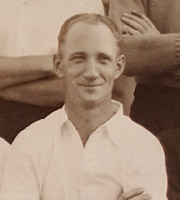
Tony McPhee
Reading career: 1938-49
149 appearances
104 goals
Claim to fame: Prolific goal-scorer who captained Reading’s London War Cup-winning side in 1941.
Scotsman (Magnus) Tony McPhee was one of our greatest goal scorers and, had his career not been interrupted by the war, he could undoubtedly be our record scorer by far. In fact if his war-time record of 212 goals is included in his record he is the most prolific scorer in the club’s history, with a total of 316 goals from 396 games in all competitions. Not surprisingly he was the top scorer in each of the 11 seasons he played for Reading. Late in his career he actually coached Ron Blackman who is still the club’s record League scorer.
Read more...
McPhee signed from Coventry in 1938 for almost £3,000 and scored 31 times in his first season. As a regular in war-time sides (he was in a listed occupation in the aircraft factory so did not serve in the forces) he often captained the side. He was indeed captain the day that Reading won the London War Cup in 1941. He was a traditional six foot tall number nine and retired at the age of 35 to take up coaching and management at Walsall.
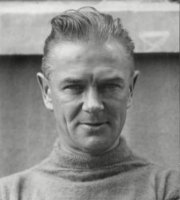
Joe Edelston
Reading career: 1939-47
Claim to fame: keeping the club going and cheerful throughout WWII
Joe was one of the first FA Staff Coaches and worked with the 1936 Great Britain Olympic squad. He was appointed manager of Reading in April 1939 having served Fulham in many capacities for 17 years. When war broke out in September 1939 the club were top of Division III (S). He steered the club through its first post-war season (1946-47) which included the club’s record 10-2 League victory over Crystal Palace.
Read more...
Joe is credited with boosting morale in the town during the dark days of WWII by ensuring Elm Park remained busy. He organised coaching sessions and fitness programmes for the locals and arranged for the great American heavyweight Joe Louis to appear in an exhibition bout on the pitch. Edelston managed the Reading side that won the London War Cup in 1941 beating Brentford 3-2 in the final at Stamford Bridge. This gave a boost to the town in dark times. Among the famous names who turned out for Reading in war-time were Matt Busby, Joe Mercer and Frank Swift and his own son Maurice (inducted to the Hall of Fame 2017).

Gordon Brice
Reading career: 1948-52
210 appearances
10 goals
Claim to fame: Dominant centre-half in a brilliant early 1950s team
Although Ted Drake’s Reading teams of the late 40s, early 50s, were known for their goal-scoring abilities, there was no shortage of top-class defenders either and Gordon Brice was the best of a very good bunch. An imposing centre half who was dominant in the air and on the ground, Gordon joined us from Wolves in March 1948 for a hefty £5,000.
Read more...
He soon established himself in the first team and from the start of the 1948-49 season to his transfer to Fulham in November 1952 for another sizeable fee he missed just two first team games (both of which were lost). Included in the period was a run of 148 consecutive first team appearances, a club record at the time. However, not all those games were in the number five shirt – remarkably he started 1950-51 as first choice centre forward, scoring three times in his first 10 games before Ron Blackman reclaimed his place in the attack.
With Gordon at the heart of the defence in the no.5 shirt Reading finished runners-up in Division Three South in 1949 and 1952 and third in 1951 – just missing out on promotion on each occasion and regularly playing in front of home crowds of over 20,000.
Gordon’s versatility did not end on the football pitch – while at Elm Park he appeared for Northamptonshire, taking 72 wickets for them in the County Championship in 25 games. In a match against the West Indies he had the ‘honour’ of being clean bowled by the legendary Sonny Ramadhin.
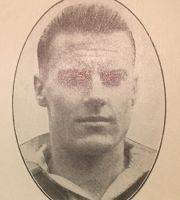
Wilf Chitty
Reading career: 1939-1948
26 (+221 war time) appearances
8 (+46 war time) goals
Claim to fame: One of our top war-time players and London War Cup winner
After successful spells with Chelsea and Plymouth Wilf moved on to Reading just before the World War II. Although he had to wait until after the war to make his League debut for Reading, Wilf was a regular throughout the conflict and was ever-present in Reading’s 1940-41 London War Cup triumph. During that period his accurate centres made him a great favourite at Reading, but no one appreciated him more than centre forward, Tony MacPhee, who was the beneficiary of most of Wilf’s crosses.
Read more...
Towards the end of the war Wilf even played some games at full back but by the time League football recommenced Wilf was back in his favoured right-wing spot and he carried on in the first team until beyond his 35th birthday, making a total of 247 first team appearances for us, scoring 54 goals. He was also a fine tennis player, once giving Fred Perry a close game. After retiring, Wilf was a scout for West Ham well into his seventies, spotting many talented youngsters including Trevor Brooking and Harry Redknapp plus one who was to become as popular at Reading as Wilf himself – Steve Death.
1950s
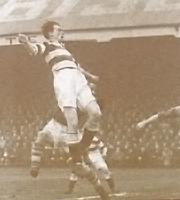
Ronnie Blackman
Reading career: 1947-54
240 appearances
167 goals
Claim to fame: Club record scorer for League goals in a season and in a career.
In 1950-51 his 35-goal League goal haul was increased by cup, friendly and reserve strikes to give him a remarkable 52 goal total while, the following season he was the first Reading player to top the division’s scorers with a club record 39 goals. In addition, that season saw him create another piece of club history when he scored in a friendly at Swindon that was the club’s first goal under floodlights.
Read more...
Both Portsmouth and Southampton failed to pick up on Cosham-born Ron Blackman but 93 goals in 67 games for Gosport brought him to Reading’s attention. Signed initially on a part-time basis in February 1947 Ron cost Reading just the statutory £10 signing on fee, along with a friendly at Gosport, a promise that was not fulfilled until 1979!
Having signed as a full professional six months later, Ron was coached by Reading’s veteran centre forward, Tony MacPhee, and under this prolific scorer Ron made great progress and in April 1948 he scored his first League goal in his third game. Even so, Ron had to wait until the following February to get a regular starting place, making the number nine shirt his own with a hat-trick on his return to the first team – the first of a club record 11 three-goal hauls or better that included two matches in which he scored five times. From then on Ron averaged well over a goal every other game to top our scorers’ lists for the next five seasons.
Ron had a powerful shot in both feet but it was his heading ability that most fans will remember him for. He combined a powerful leap with perfect timing to score 96 of his 197 with his head – even more remarkable when, in one of his first games for the club, he was criticised in the local press for a lack of heading ability! By the summer of 1954 Reading were struggling financially and so reluctantly agreed to sell their club captain and record scorer to Nottingham Forest for £6,600, a record fee that did little to placate Ron’s legions of fans. The move to Forest was not a success and although Ron fared better at Ipswich under their new manager, Alf Ramsey, a series of injuries meant that he never repeated his Elm Park form.
After a spell in non-League football, Ron left the game and worked for Reading GPO until his retirement. Ron was a tough competitor on the pitch but a perfect gentleman and his appearances at Elm Park and the Madejski Stadium were always greeted by warm and enthusiastic applause by Reading fans, many of whom had never seen him play. There was genuine sadness throughout the club when he died in February 2016 at the age of 90, leaving goal-scoring records that are unlikely to be surpassed.
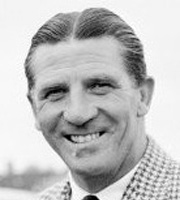
Ted Drake
Reading career: Manager 1947-52
Claim to fame: Reading’s first ‘modern’ manager who went on to Chelsea and Barcelona.
This legendary ex-England and Arsenal centre forward took his first break in league club management with Reading in 1947. Here he developed a youth system that produced Reading greats like Sylvan Anderton, Johnny Brooks, Maurice Evans, Stan Wicks and Jimmy Wheeler. His attractive, high-scoring side narrowly missed promotion from Division Three South on three occasions.
Read more...
Drake left to manage Chelsea in 1952 and in 1954-55 took them to their first Football League championship title and later had a spell as assistant manager at Barcelona. One of Reading’s best ever managers of a great team that didn’t quite make it. But he did have the rare distinction of managing Reading to victory over Arsenal – at cricket! Drake had been a first class cricketer before WWII playing occasionally for Hampshire.
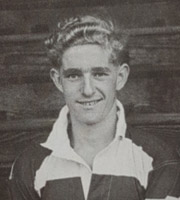
Johnny Brooks
Reading career: 1949-53
49 appearances
6 goals
Claim to fame: First Reading-born player to play for England.
Johnny may have only played 49 games in total for Reading but he was the first Reading born player to play for England. He played for local sides Mount Pleasant Youth Club, Coley Boys and Castle Street Institute before joining Reading ground staff in February 1949. Turning professional in April 1949 he was part of manager Ted Drake’s youth plan and made his first team debut in April 1950.
Read more...
His career at Reading was interrupted by National Service and he was only able to focus on football from 1952-53. His creative abilities at inside right, beautifully balanced and skilful, had many clubs watching him. Tottenham signed him in exchanged for Dennis Uphill, Harry Robshaw plus £ 3,000 in a deal worth £15,000. On the 14th November 1956 he made his England debut at Wembley against Wales in a game which England won. He played twice more for England, scored two goals and was again on the winning side.
In 1998 at the age of 66 he took part in the last competition played at Elm Park, an over 40s six-a-side where he showed that he still had an abundance of skills. He was still a twinkle-footed dribbler in his seventies when he played in STAR’s 2003 re-enactment of Reading’s first ever game back in 1872.
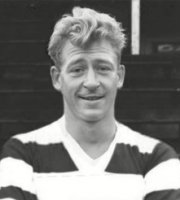
Jimmy Wheeler
Reading career: 1952-1968
Apps 452+1
168 goals
Claim to fame: a popular and prolific scorer and reserve team manager
Jimmy was born in Reading and played for Huntley & Palmers before joining Reading as an amateur in May 1952 and then signing professional in August 1952. Prior to joining Reading he had won the National Cup with Berkshire Boys. He started as a left winger but played across the forward line and became a prolific scorer. He scored 10 or more goals in all competitions for nine consecutive seasons from 1956-57 and was top scorer from 1957-58 through to 1960-61 when he scored 35 first team goals. Jimmy was a great favourite with the crowd and a real trier.
Read more...
He broke his leg in September 1964. In 1965-66 he only played two first team games but had great success in his new role as manager of the reserve side which went on to win the Football Combination Second Division title. The reserves attracted higher attendances than the first team at one point and Jimmy won the Player of the Season for 1965-66. Wheeler left Reading in 1968 to manage Bradford City and guided them to promotion from Division Four in his first season.
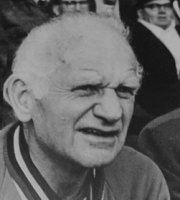
Jimmy Wallbanks
Reading career: 1953-1975
Apps: 58
1 goal
Claim to fame: Reading’s best-known trainer and probably the first physio to manage the club
Jimmy had a short League career with Reading as a centre-half, joining the club from Millwall in 1938 and continued to play during the war. He spent a few years assisting Bill Shankly at the start of his career at Carlisle before coming back to Reading where he spent the rest of his life. But he is best remembered as the long-serving trainer and physio, a position he first took up in 1953 and held until his testimonial match in 1975.
Read more...
He delighted fans with his unusual high-stepping run onto the pitch to treat injured players, a style that owed something to his days as a professional sprinter, and that curious bladder-like little bag he carried. When Jack Mansell was sacked in 1971 Jimmy enjoyed a 15 games spell as care-taker manager that included navigating past a difficult away tie at Blyth Spartans.
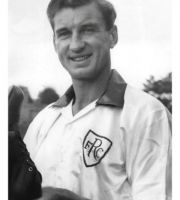
Stan Wicks
Reading career: 1946-1954
180 appearances
1 goal
Claim to fame: Local boy who stood tall, played strong and won honours
Stan was born in the town and played for Castle Street Institute before signing for Reading in May 1946 as an 18 year-old. He made his debut in the 1949-50 at full-back and enjoyed a largely unbroken run in the no.3 shirt for the next three seasons in which Reading came close to promotion. When Gordon Brice left Stan took on his role at centre-half but after half a season followed Gordon to west London. Stan moved to Chelsea for £13,300 in January 1954, to re-join his former Reading manager Ted Drake. He was a member of the Chelsea team that won the First Division Championship in 1954-55 under the captaincy of Roy Bentley.
Read more...
At 6ft 2ins and over 13 stone he was a relative giant at the time and a forceful defender. Besides a league champions medal he represented the FA side against Cambridge University, played for the Football Combination side and gained an England B cap in 1953. A bad knee injury ended his career in August 1957 at a point when he might possibly have gone further.
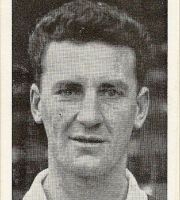
Ray Reeves
Reading career: 1947-1961
317 appearances
32 goals
Claim to fame: The club’s fiercest and best penalty-taker
Ray was born in Reading, joined the ground staff in 1947 and turned professional in 1949. He won caps for England at youth level but had to wait to November 1952 for his first team debut at the age of 21. Ray alternated between left-back and centre-half, was firmly established by 1956 and sometimes captained the team. He left Reading in 1961 for a brief cameo with Brentford but returned to the town in retirement.
Read more...
Like many players of that era he earned the nickname ‘Bomber’ for his cannon-ball shooting. Ray had a fearsome physical presence and a ferocious left foot. He scored many thunderbolts from long range as well as a club record 22 penalties in his long career. His tally of 32 was unusually high for a defender in those days.
Off the field Ray was a softly spoken and humorous gentle giant and continued to follow the club as a supporter until his death in 2007.
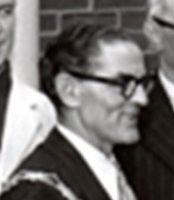
Bert Kersley
Reading career: 1954-1964
Supporters Club chairman
Claim to fame: Local politician who successfully revived the supporters’ club
In late 1950s and early 1960s the Supporters’ Club was of real importance both as a source of additional funds and as an out-sourced volunteer workforce of considerable size (providing for instance gatemen and tea-bar staff). Its chairman was Bert Kersley.
Read more...
Kersley had played a significant part in reviving the dormant Supporters’ Club in 1954 and helped tide it over difficult moments in 1959, when two of its officials were jailed for fraud. He was a man with a public reputation, an alderman and a former Mayor (1947-49), and in 1963 became the (Labour) chair of the Borough Council finance committee. Reading FC could not have functioned as it did without this support and out of politeness, if not necessity, Kersley sometimes attended, as an observer, the club’s board meetings. He stepped down from his position in 1964.
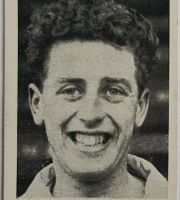
Sylvan Anderton
Reading career: 1952-1959
178 appearances
19 goals
Claim to fame: Silky skilled wing half who went to play with Jimmy Greaves at Chelsea
A Reading born youth product from Battle Athletic, Sylvan made his debut in 1952. It wasn’t until 1956 he became a regular at right half and was soon acclaimed as the best in that position in the division. He had great skill on the ball and an eye for a pass. His best season was 1957-58 when he missed only one match as Reading finished fifth in Division Three South and reached the final of the Southern Professional Floodlit Cup.
Read more...
In 1959 he joined First Division Chelsea for the then huge fee of £15,000 and played alongside Roy Bentley and Jimmy Greaves for a couple of seasons before finishing at QPR.
1960s
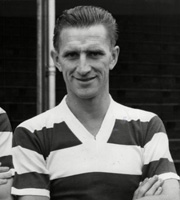
Johnny Walker
Reading career: 1957-1966
319 appearances
27 goals
Claim to fame: A football man through and through and a great character.
Johnny Walker signed for Reading on his 29th birthday – and still managed over 300 games over 8 seasons for the club such was his love of the game. He captained an entertaining side which generally finished near the top of the old Third Division and was a dead-eye penalty taker too. Despite never losing his Glasgow accent, and love of Rangers, Johnny settled in Reading and involved himself in local football and was a well-loved character full of wry humour and practical jokes.
Read more...
Walker’s professional career started with Wolves in 1947. Skilful and slightly built he made his mark in the First Division as a goal-scoring inside forward before joining Southampton in that role in 1952 for the then large fee of £12,000.
In 1957 he signed for Reading and, as the years went by and his pace diminished, he worked his way backwards from inside forward to wing half and then right full back where, on occasions, he partnered Gordon Neate. Many of his 27 goals for Reading were scored from the penalty spot, the cool head of a wily veteran coming to the fore. His party trick was to dance a jig on the spot and then speed past his baffled opponent. The nearest he came to any honours at the club was as a runner-up in the Southern Professional Floodlit Cup final in 1958.
After retiring from professional football at the age of 37 he assisted various local clubs including Wokingham and Tilehurst. For many years he worked for the Post Office in Reading and then at Theale Social Club. In retirement could often be spotted in Broad Street wearing a shirt with RFC embroidered on the breast – Rangers FC!
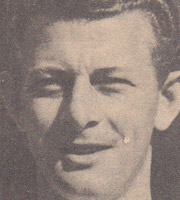
Gordon Neate
Reading career: 1956-2009
107 appearances
2 goals
Claim to fame: 53 years of loyal service to the club
Gordon Neate is one of Reading Football Club’s most loyal and popular figures, having served as player and groundsman for over half a century. Given the nickname ‘Fred’ by friend and colleague Maurice Evans, the local lad arrived as an apprentice at Elm Park at the age of 15 in 1956 after an impressive career in schoolboy football.
Read more...
Gordon played for the club’s minor teams before turning professional in March 1958 and made his first team debut away at Colchester in April 1959. His home league debut came on the final day of the season, when Reading thrashed Accrington Stanley 5-0.
The full-back was in and out of the side over the next seven years due to terrible luck with injuries, and was forced to hang up his boots in 1966 at the age of just 25. In his last playing season Gordon had some consolation when he picked up a Football Combination Division Two championship medal as part of the reserve team. Reading chairman Alf Smith then offered Gordon the post of groundsman and, after assisting Bill Smith briefly using the knowledge he’d gained working on the pitch during his time on the ground staff, he took on the task of tending the turf along with general ground maintenance. During his time as groundsman there was a competition to find out who had the hardest shot in the club. Gordon won it – beating the two goalkeepers into second and third place. All the forwards missed the target! Gordon liked a laugh, a chat and a friendly word with the fans – except when they got on his pitch.
Gordon’s long service and loyalty was recognized as he received a Canon League Loyalty Award in 1985 and a Football League Long Service Award in 1996. He followed the club to the Madejski Stadium in 1998 as groundsman before eventually retiring in 2009 at the age of 68, meaning that he had served Reading Football Club with distinction for a remarkable 53 years.
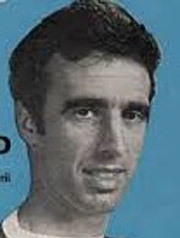
Dick Spiers
Reading career: 1956-69
492+2 apps appearances
4 goals
Claim to fame: Loyal one club man who once held the club’s league appearance record
Dick Spiers played for Cholsey United before joining Reading in 1955 originally as an amateur. Competition from other centre-halves and National Service disrupted his earlier career but from Christmas 1960 until September 1966 he missed only 6 games. He was a tall, lean, deceptively strong defender whose long neck aided his aerial battles.
Read more...
Spiers regularly captained Reading and went on to hold the club’s record for first team appearances, his last game coming in 1969. Ironically this was eventually beaten by a player he scouted for the club, Martin Hicks! He was rewarded with a star-studded testimonial match in 1970 in which he scored a rare goal.
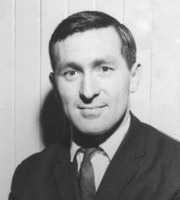
Denis Allen
Reading career: 1961-70
373+4apps appearances
95 goals
Claim to fame: Hugely versatile and popular player – and also a Malaya international
Denis, born in Dagenham, was spotted by Charlton Athletic when captaining a local team that included Bobby Moore. He did not make an impression at The Valley so moved onto Reading for a small fee in 1961and became one of the club’s all-time bargains. Denis played throughout the sixties, proving to be very versatile by playing every position from 4 to 11 and was also the stand-in goalkeeper.
Read more...
A very popular player, he was nicknamed “Daisy” by the fans. In his first season, 1961-62 Denis was Reading’s top League scorer as he was for the following two seasons. He also scored a hat trick in Reading’s first win the League Cup against Chester (4-2). Denis was converted into a scheming midfielder adept from dead-ball situations and then towards the end of his Reading career he played as a centre-half / sweeper. Denis was sold to Bournemouth but his popularity was demonstrated when over 12,000 turned up for his testimonial.
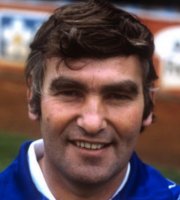
Maurice Evans
Reading career: 1953-66 and 1974-84
Apps: 459
16 goals
Claim to fame: A much-loved club man who did everything well and in good spirit
Maurice could be inducted for the 1950s or 1970s too! He was born in Reading and played for Didcot’s A team before joining Reading and turning professional in September 1953, making his debut in October 1955 at left half. From 1961-62 to 1963-64 he only missed 5 league games in total. His strong but fair play, good character and all-round effort made him a firm favourite with the fans. Towards the end of his career he was tried at full-back and made the last of his 459 appearances (16 goals) in October 1966. He was never booked or sent off.
Read more...
On leaving Reading Maurice (‘Mo’) worked as a coach at Andover and Shrewsbury before returning to the club as assistant manager in 1974. He was involved in Reading’s first promotion for 50 years in 1976, became manager in 1977 and guided Reading to the Division Four title in 1979 with an attractive, attacking, side. The years that followed were a financial struggle with the club up for sale and relegation in 1983 but it was a great shock when Maurice was sacked in 1984 with the club positioned in the promotion places (and eventually going up). Despite then becoming manager of Oxford United Maurice retained his honorary position as a vice-president of the Supporters’ Club.
Maurice returned for a third time, sadly all too briefly, in 2000 as Director of Football. He was an immensely popular and respected figure throughout the game. A plaque commemorating his life hangs outside the ticket office – ‘Player, Manager, Gentleman’ it reads.
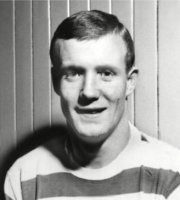
Colin Meldrum
Reading career: 1963-1969
Apps: 302+2
9 goals
Claim to fame: The first (and second) holder of the supporters’ Player of the Season trophy
Colin signed for Reading from Watford in April 1963 for £1,300 becoming one of manager Roy Bentley’s best signings. He was a virtual ever present from April 1963 to October 1969 mainly at left-back. Colin was Reading’s first Player of the Season in 1963-64 and retained the trophy the next season. He often captained Reading and also played at centre half and, in desperate moments, at centre-forward. Meldrum was one of our first overlapping full-backs as well as being a tough-tackling Scot who inspired team-mates by example. Colin made a total of 334 (4) first team appearances and scored 9 goals.
Read more...
He moved to Cambridge United where he gained promotion to the Football League in 1969-70 and scored their first ever league goal. After retiring he had a long career in the lower leagues as a manager / coach.
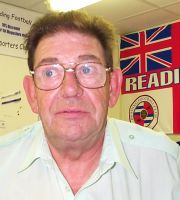
Mick Foster
Reading career: 1955-to date
Supporter
Claim to fame: Decades of hard work and strong support for both the supporters’ club and the football club
No Reading fan spent more time at Elm Park than Mick Foster who, in his five decades of watching the club at our old ground, watched virtually every first team and reserve game played there. But Mick didn’t just watch – as a member of the Supporters’ Club committee for that period, he would arrive two hours before kick-off and leave about an hour after the final whistle. Mick’s match days were spent first setting up and then running the club shops, selling old programmes and souvenirs with a ‘brusque’ customer service style all of his own, raising valuable funds at a time when the few hundred pounds raised were vital to the club’s survival.
Read more...
More importantly, Mick was instrumental in launching Supporters’ Club coaches to away games, a service that still flourishes to this day and – at times – hired special trains for away trips. He also spent many hours on a voluntary basis helping football club secretary Fred May during the impoverished days of the 1960s.
Somehow Mick gathered an astonishing array of senior contacts in the game, most notably a good friendship with Matt Busby.
Mick’s booming voice was a feature of games in the early Sixties and he is thought to have been the instigator of the legendary ‘Your Rs’ shout (which lives on as URRRZ). A Life Member of STAR, Mick now sufferers from mobility problems but remains a season ticket holder and still attends as many games as he can.
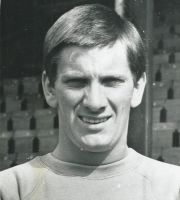
Arthur Wilkie
Reading career: 1959-1968
188 appearances
2 goals
Claim to fame: Holds the EFL record for most goals in a game by a keeper
Arthur turned professional with Reading in October 1959 having been capped for England Youth. He made his debut as a goalkeeper in 1961 and in only his 11th game set a Football League record which still stands today. Injured in the shoulder, and in the days before substitutes, he was moved to the wing versus Halifax and scored twice in a 4-2 win in August 1962 – the most goals ever scored in a league match by a player who took the field as a goalkeeper.
Read more...
Wilkie was an agile and acrobatic shot-stopper who made a total of 188 first team appearances but did not add to his goal tally in the first team. However, towards the end of his career he did play outfield for the reserves and scored on his debut.
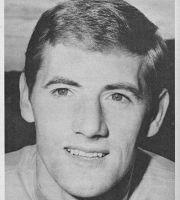
George Harris
Reading career: 1966-1969
154+2 appearances
65 goals
Claim to fame: Record goal scoring left winger with a phenomenal shot
George joined Reading for £4,500 in July 1966 from Watford where he had been an established Third Division player. Harris played mainly on the left wing but had an amazing goal-scoring record thanks to his phenomenal ability in the air and powerful left foot. George broke Reading’s 25 year-old goal scoring record for a winger when netting 25 goals in his first season, 1966-67. The following season he went one better and scored 26 goals in total. George made a total of 154 (2) first team appearances and scored 65 goals.
Read more...
He left the club with Colin Meldrum and helped Cambridge U secure promotion to the League in 1970 before returning to Reading where he dies in February 2022.
1970s
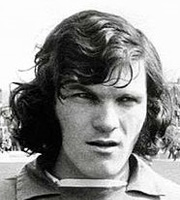
Steve Death
Reading career: 1969-82
537 appearances
0 goals
Claim to fame: One of Reading’s greatest goalkeepers and the holder of several records.
One of the most recognisable characters of the Reading teams of the1970s Death originally signed on loan from West Ham in November 1969. The move was made permanent in 1970 for a club record fee of £20,000 and Steve went on to make 471 league appearances and 537 total appearances for the club and only bettered by Martin Hicks.
Read more...
Death shared England Schoolboys duties with Peter Shilton but only made one First Division appearance for West Ham. At just 5’8”, he had to make up for his lack of inches with agility and bravery and was capable of some astonishing saves.
His kicking wasn’t great, his attention sometimes wandered and his attitude to training wasn’t flawless but he was nevertheless much loved by Reading fans as he played his part in the club’s promotions from Division Four in 1976 and 1979.
At the end of the latter campaign he set a league record of 1,074 minutes without conceding a goal, extended briefly to 1,103 minutes the following season before being beaten by an own goal whilst he was semi-conscious. He won the Reading Player of the Year on a record four occasions and was also chosen for two PFA awards in 1974 and 1979.
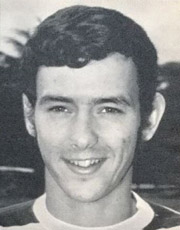
Gordon Cumming
Reading career: 1969-77
311+2 appearances
62 goals
Claim to fame: Tricky goal-scoring winger who captained our first promotion side in 50 years.
After a highly successful start as a schoolboy and youth footballer Scottish-born Cumming signed for Reading from Arsenal in December 1969. As a slightly-built, skilful right winger Gordon made an immediate impact in Jack Mansell’s brilliant ‘one touch’ team of early 1970. Cumming was twice top scorer (a cool penalty-taker) and Player of the Season in 1972.
Read more...
In his late 20s he took up a midfield berth, and the club captaincy, and alongside the experienced Eamon Dunphy, schemed Reading to the club’s first promotion in 50 years in 1976 with grit, energy and good short passing. Years toiling in Division Four took its toll on Cumming’s small frame and he retired from football in 1978. He continues to live locally and support the club from the stands.
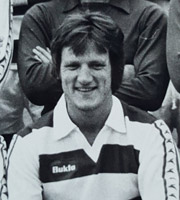
Steve Hetzke
Reading career: 1971-82
293+10 appearances
33 goals
Claim to fame: Once our youngest ever player who went on to win two promotions.
Steve joined Reading from Hungerford Town as an apprentice in June 1971 and signed professional in June 1973. He became Reading’s youngest ever League player against Darlington in December 1971 at the age of 16 years and 193 days. He played regularly in the centre of the defence but competition for places meant that Steve did not play more than half of the games each season until 1978-79.
Read more...
That season Steve moved up to a striker’s role starting 42 League games and scoring 9 goals as Reading became Champions of Division Four. The next season Steve moved back into defence and then captained the club in 1981-82. In 1982 he left Reading and joined Blackpool, the first of several other clubs he played for before retiring.
Understandably nicknamed ‘Big ‘Un’ Steve was tall and strong in the air, with a decent touch on the ground and a powerful shot. Since retirement Steve has worked for the FA and PL in the coaching, youth development and technical domains and is now an Academy mentor at Swansea City.
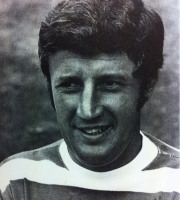
Bobby Williams
Reading career: 1969-1971
Apps: 67+5
22 goals
Claim to fame: A Bristolian who fell in love with the club and helped it in many ways
Bobby joined Reading in 1969 and served the club as a player, a coach and as a scout, a role that he has performed until very recently. He played for both Bristol clubs and Rotherham (under Jack Mansell). Reunited with Mansell at Reading Bobby played a key left-wing role in the hugely entertaining team of 1969-70, scoring 16 goals, often ghosting in at the far post – hence his nickname ‘The Shadow’. The following season began brightly with Williams captaining the team against Manchester U in the Watney Cup but was more of a struggle for Bobby, now aged 30, and ended in relegation and with him getting a free transfer. He played 67 times and scored 22 goals.
Read more...
Three years later he returned as reserve manager and then youth team coach, helping bring through such talents as Ady Williams, Neil Webb and Lawrie Sanchez. He has also served both Reading Football Supporters’ Club and its successor STAR loyally in the role of Vice-President and is still involved in the life of the club.
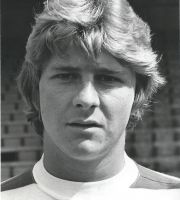
Gary Peters
Reading career: 1975-1979 and 1985-1988
277+17 appearances
12 goals
Claim to fame: Won promotion three times in very different Reading teams
Gary joined Reading from Guilford City in May 1975 for £1,000 at the age of 20. He was a tall, strong, hard-running and often attacking full-back. In his debut season he played 30 times at right back as Reading finished third and secured promotion from the 4th Division in 1975-76. Then in 1978-79 he was part of that record-breaking (1103 minutes without conceding) defence that won the 4th Division title and was also picked for the PFA Team of the Year for the Division. On the strength of these performances Gary joined Fulham for £ 40,000 in 1979.
Read more...
He won promotion with both Fulham and Wimbledon (twice) before re-joining Reading in 1985, essentially as a squad player. However, he was almost ever-present at right-back, then centre-half, as Reading clinched the 3rd Division title in 1985-86. One of his final appearances was a substitute near the end of Reading’s Simod Cup victory at Wembley in 1988.
He then re-joined Fulham. After retiring he gained another promotion as manager of Preston NE in 1996, where he signed David Beckham on loan, and later managed Exeter and Shrewsbury.
![mike_kearney[1] mike_kearney[1]](https://star-reading.org/wp-content/uploads/2021/03/mike_kearney1-167x200.jpg)
Mike Kearney
Reading career: 1978-1982 and 1990-2018
157+11 appearances
45 goals
Claim to fame: Versatility and dedication on and off the pitch
Few men can claim to have served the club in as many roles as Glasgow-born Mike Kearney. The legendary Maurice Evans signed him three times. The first was for Shrewsbury Town where he made his debut in February 1973. He was switched from centre forward to centre half as Shrewsbury won promotion to the Third Division. In March 1977 he moved to Chester for £8,000 and then re-joined Maurice, now at Reading, for £10,000 as a forward in February 1978. Reading won the Fourth Division title in his first full season at the club (1978-79). After finishing as the club’s top scorer in 1979-80 with 16 goals, Mike was sold back to Chester for £ 50,000, their then record fee. This did not go well and he returned to Reading in October 1980. He played as a tall, strong forward, in a deeper role and also in defence. He broke a bone in his foot in December 1982 and this eventually forced his retirement from League football, although he later played for Marlow and Basingstoke Town.
Read more...
In 1990 he returned to Elm Park once more to run the Royals Rendezvous social club on Tilehurst Road with his wife Grace, for a hospitable and enjoyable eight years. When the Rendezvous closed and the club moved to the Madejski Stadium Mike then became the first Promotions Manager. Later still he took up a position as facilities manager at the new Hogwood training ground.
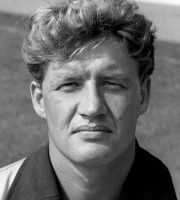
Mark White
Reading career: 1977-1988
303+17 appearances
13 goals
Claim to fame: The last Division Four (and promotion-winning goal) scored at Elm Park
Mark came to Reading as an 18 year-old trialist from Sheffield United in 1976. He made his debut in 1977 and made the no.3 shirt his own for the next few seasons. An ever-present as we won the Division Four title in 1979, setting the Football League record for most minutes without conceding a goal, Mark was a cultured and skilful left-back. In 1984 he scored a delightful goal from a free-kick to clinch promotion again in our last home game ever in Division Four.
Read more...
The combination of his skills and tackling led Ian Branfoot to convert him into a midfield player and in 1985 White played in all 13 consecutive wins from the start of the season – a still-standing league record. Thereafter he was again dogged by serious injuries and appeared only sporadically for us in Division Two before retiring in 1988.
His experience of many and serious injuries and long days in recovery may have influenced his post-retirement choice of career as he became a chartered physiotherapist, often working locally in Reading.
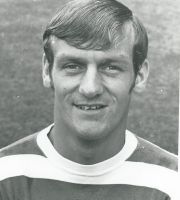
Les Chappell
Reading career: 1969-1974
223+8 appearances
90 goals
Claim to fame: Classy goal poacher with a hat-trick record
Les joined Reading on a free from Blackburn Rovers in July 1969 and was key to Reading’s high goal scoring in 1969-70. He was top scorer with 24 League goals including a 9-minute hat trick against Barnsley, concluded with a spectacular diving header. Despite being 5ft 8ins tall he scored many headed goals, his efforts from near post corners being a speciality. His classy ability meant his was occasionally employed in midfield.
Read more...
In the 1973-1974 season Les was the League’s top goal scorer at Easter but an ankle injury kept him out for the rest of the season, although he was Reading’s top goal scorer with 28 goals in total, including a club record-equalling four hat-tricks.
He moved to Doncaster in December 1974 after playing a total 223(8) first team games for Reading and scoring 90 goals. His League career finished at Swansea and he continued in the game at lower levels in management and coaching.
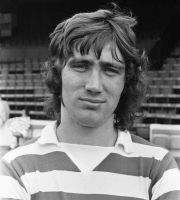
Robin Friday
Reading career: 1974-1976
135 appearances
53 goals
Claim to fame: Both the greatest player you never saw and the player of the millennium!
‘The Greatest Footballer You Never Saw’. Except the older ones of us saw him many times, what a talent! Voted Player of the Millennium at Reading and top cult hero at Cardiff.
Read more...
From 1974-1976 – three calendar years – Robin entertained Reading fans like no-one else and inspired the club’s first promotion for 50 years. He caused mayhem on and off the pitch and was out of the professional game by the age of 25, in jail in his 30s and dead at 38 – a great talent gone to waste. But his legend has mushroomed and he’s probably the world’s most famous 4th Division footballer – inspiring a trolley-load of T Shirts, CDs and books.
At centre-forward he had the lot, except a bit of pace. A great dribbler, a wonderful shot (the greatest goal you can’t quite describe versus Tranmere in 1976), good in the air and hard in the tackle.

